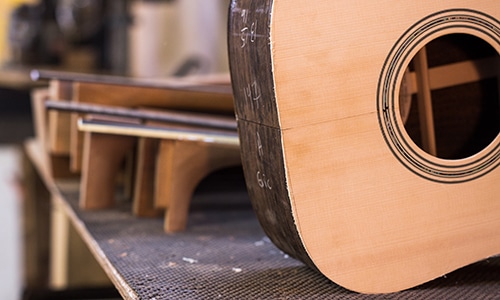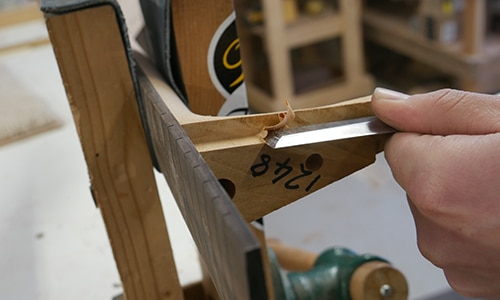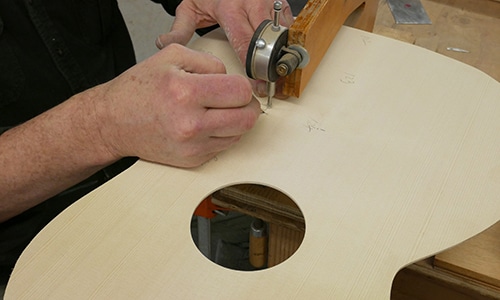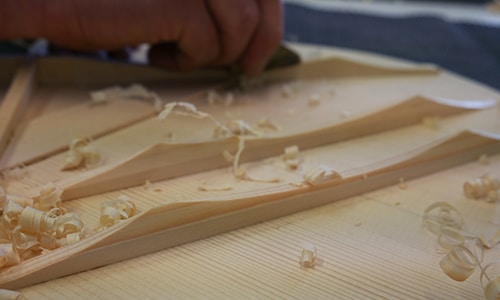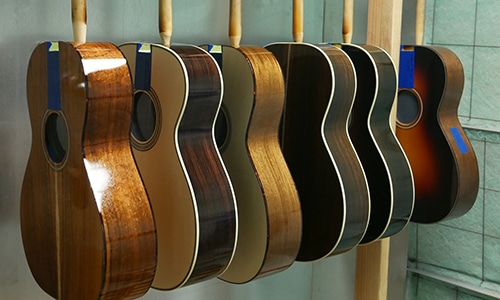The Handbuilt Difference
Adirondack (Red Spruce) Tops
On our Spruce top models, Adirondack Spruce is offered as the standard top wood but other excellent woods like Sitka Spruce, European Spruce, Lutz Spruce, Western Red Cedar, Port Orford cedar and more are used for the soundboards on our guitars. Additionally, we’re working with thermally aged tops and from time to time we come across unique supplies of top woods, such as our recent procurement of Sitka Spruce that was submerged for several decades as a part of a barge in Alaska.
Our Tonewoods
Thompson Guitars are built using the finest woods for back and sides available today. We are constantly seeking suppliers of older salvaged woods and sustainable new woods. We currently offer Shipwreck Brazilian Rosewood, 5-A Brazilian Rosewood, East Indian Rosewood, Honduran Mahogany, Koa, Oregon Myrtlewood and a striking flamed Walnut. Also in the works are limited editions of Cuban Mahogany, Sinker Mahogany, Quilted Mahogany, Flamed and Quilted Maple.
Dovetail Neck to Body Joint
Use of a dovetail joint for connecting the neck of the guitar to the body has long been recognized as a stable and strong method of construction for steel string instruments. Our dovetail joints are 5/8” deep and are an integral piece to the signature Thompson Guitars tone; they provide a vital sound-conducting link from the body to the neck and also serve as a functional construction element, allowing for disassembly of the neck and body if needed.
Hand-Graduated Tops
Quality material deserves to be heard so we take extra measures to achieve the most tone that a piece of wood possesses. We hand-graduate our soundboards to assure each top delivers the utmost in responsiveness and tone. Each top is sanded in a symmetrical pattern so the bass side of the top thins out from the bridge plate area. The same is done for the treble side of the top however, the treble side is left a little thicker than the bass side. The resulting top has the ability to excite more vibrational energy and therefore deliver superb tone and volume.
Hand Carved Braces
Just as our tops are individually hand graduated, the braces on our tops are hand carved and scalloped. This traditional approach gives us the control to achieve the most from the soundboard. We can lighten the overall mass while retaining strength. There are many configurations for the placement of the X brace. We generally use the 1930’s position referred to as Advanced X or Forward Shifted X. This X position frees up the rocking movement of the bridge and the top is allowed to move more, once again adding to responsiveness, volume, and tone.
Nitrocellulose Lacquer
This mainstay finish, which was developed in the 1920’s, does a wonderful job of showing the beauty and grain of the wood. It hardens but never completely cures like a Poly finish, which makes it an excellent protector. It retains a degree of flexibility and is therefore not as constricting as other finishes, which adds to the guitar’s resonance and volume. Nitrocellulose ages very well and a guitar finished with this lacquer may get scratches and dings as any well-loved instrument will but the beautiful patina adds character that thick plastic finishes can’t come close to.


